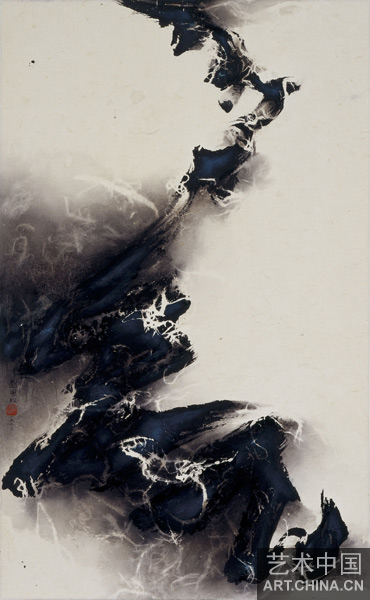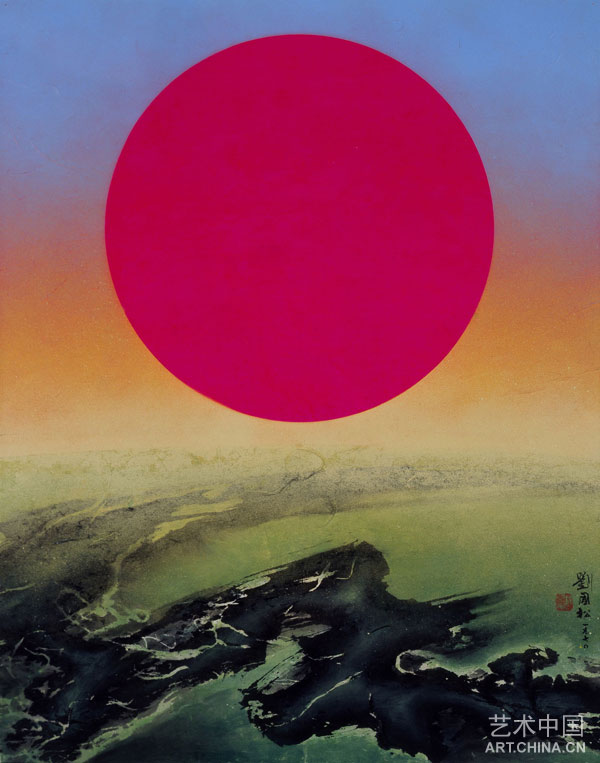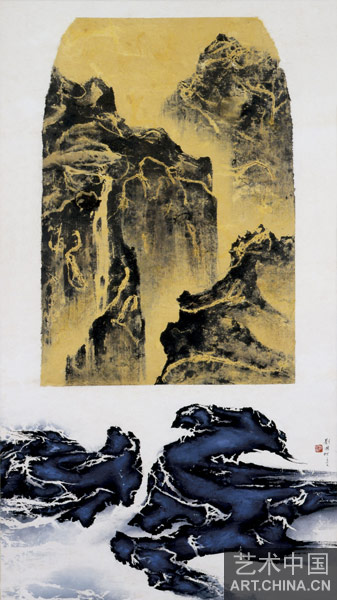|

Rising Toward Mysterious Whiteness
《升向白茫茫的未知 》
94×58cm
1963年
北京故宮博物院將于2007年4月26日下午兩點(diǎn)半,在故宮武英殿為劉國(guó)松舉辦“宇宙心印:劉國(guó)松繪畫(huà)一甲子”展覽開(kāi)幕式。展覽由中華文化基金會(huì)籌辦,李鑄晉教授、張頌仁教授擔(dān)任策展人,展覽時(shí)間至5月26日止。
劉國(guó)松在上世紀(jì)六十年代在臺(tái)灣即大膽提出以放棄筆墨語(yǔ)言,來(lái)解決“中國(guó)畫(huà)的現(xiàn)代化”的問(wèn)題。他要“革中鋒的命、革筆的命”。他說(shuō):“筆就是點(diǎn)和線(xiàn),墨就是色和面,皴就是肌理”;“模仿新的,不能代替模仿舊的;抄襲西洋的,不能代替抄襲中國(guó)的”。透過(guò)西方抽象藝術(shù)的啟發(fā),從而形成深具媒材實(shí)驗(yàn)意識(shí)的前衛(wèi)創(chuàng)作,背離傳統(tǒng)的筆法與意境。在作品的表現(xiàn)上,尋求各種前所未有的可能形式,并在“現(xiàn)代”與“水墨”的雙重議題上,尋求最大的結(jié)合與突破。他并在臺(tái)灣成立五月畫(huà)會(huì),以群體之力推動(dòng)傳統(tǒng)書(shū)畫(huà)的變革,產(chǎn)生了深遠(yuǎn)的影響。七十和八十年代在香港中文大學(xué)任教職,匯合了香港的新水墨界。八十年代初劉國(guó)松到大陸巡展,沖擊了當(dāng)時(shí)亟待思變的畫(huà)壇,結(jié)識(shí)了吳冠中,鼓勵(lì)了谷文達(dá)。現(xiàn)代水墨因此成為中西文化融合的畫(huà)種。它是現(xiàn)代的,又是中國(guó)的;既是與西方對(duì)話(huà)的,又是民族的。
整個(gè)20世紀(jì)中國(guó)書(shū)畫(huà)的發(fā)展,是一部應(yīng)對(duì)與因應(yīng)“現(xiàn)代性問(wèn)題”的焦慮史。到底書(shū)畫(huà)該如何追隨時(shí)代,迎上西方,趕上當(dāng)代,而又不失了民族藝術(shù)之本體?在這一思考中,劉國(guó)松無(wú)疑有著舉足輕重的歷史影響。
如今,代表書(shū)畫(huà)正統(tǒng)與主流的故宮博物院為劉國(guó)松舉辦展覽,意味了創(chuàng)新的現(xiàn)代水墨藝術(shù)已被接納入正統(tǒng)體系之重大意義。
在展覽開(kāi)幕隔日之4月27日,將在故宮由李鑄晉教授主持“書(shū)畫(huà)與現(xiàn)代化 : 書(shū)畫(huà)在現(xiàn)代藝術(shù)中的流變與波瀾”學(xué)術(shù)討論會(huì)。藉此展覽機(jī)會(huì),將借劉國(guó)松現(xiàn)象對(duì)現(xiàn)代水墨的發(fā)展進(jìn)行歷史回眸,全面反思“書(shū)畫(huà)與文藝現(xiàn)代化”的整體問(wèn)題。探討五十年來(lái)書(shū)畫(huà)在現(xiàn)代藝術(shù)的各種沖擊下,到底出現(xiàn)什么樣的理論與反思?到底產(chǎn)生了什么樣的波瀾與變化?而我們應(yīng)在目前的問(wèn)題上繼續(xù)推進(jìn)哪些問(wèn)題與思考?
展覽畫(huà)冊(cè)由紫禁城出版社出版, Wilbur Ross 先生夫人贊助。
有關(guān)展覽之查詢(xún),請(qǐng)致電香港+852-2526-9019 北京聯(lián)絡(luò)人趙孝萱 13683189113
或電郵香港漢雅軒tzchang@hanart.com或 chhsuan0625@163.com與我們聯(lián)絡(luò)。
Press Release
Universe in the Mind: 60 Years of Painting by Liu Guosong
Presented by the Palace Museum with the support of the Consortium Chinese Culture Foundation
Opening: 26th April, 2007, Thursday, 2:30 pm
Exhibition until 26th May, 2007
Opening Hours: 8:30am – 4:30pm
Artist will be present at the opening
Venue: Wu Ying Palace, Palace Museum, Beijing
LIU Kuo-sung, whose career as a leading painter in Taiwan, was born in 1932 in Anhui, China. He moved to Taiwan in 1949 and graduated from the National Taiwan Normal University in 1956.
In the 1960s in Taiwan Mr. Liu proposed to “modernise Chinese painting” by abandoning its attachment to traditional “aesthetics of brushwork and ink-play”. He proposed to “revolutionise the zhong-feng (centre-point) brushwork” and “revolutionise the brush”. Mr. Liu said: “Brushwork simply means dot and line, ink-work means colour tone and surface, and texture-stroke means textural structure.” “Imitating the new is not the same as imitating the old; copying the West is not the same as imitating Chinese masters.”
Inspired by western abstract painting, Mr. Liu established an experimental approach to the artistic medium in order to depart from traditional brushwork and its aesthetic taste. He attempted varied approaches to artistic expression, seeking resolution and breakthrough under the two anchors of “modern” and “ink art”. Through the “Fifth Moon” art society, of which Mr. Liu was founder, calligraphy-painting reform was expanded into an art movement in Taiwan. In the two decades of the 1970s and 1980s Mr. Liu was professor of art at the Chinese University in Hong Kong, and became closely involved with new ink painting outside of Taiwan. In the early 1980s his touring exhibition in China made a strong impact on the emerging creative scene, establishing a lasting influence. With the concerted efforts of artists from China and abroad modern Ink art has now established itself as an independent art form born of Chinese and western influence. It is both modern and Chinese, culturally grounded and in dialogue with the West.
In presenting the exhibition “Sixty Years a Painter: Retrospective Exhibition of Liu Guosong”, the Palace Museum, as the symbols of the Chinese lineage, signifies the acceptance of the innovative new ink painting movement into its cultural fold. Therefore, it is significant to take the opportunity of this retrospective exhibition to review the historical development of modern ink painting, so as to critically assess broader issues relating to calligraphy-painting and cultural modernisation. It is important to review the theories and strategies that have arisen in the part half century out of response to the growing predominance of modern art.
Fully illustrated catalogue published by the Forbidden City Press, sponsored by Mr. and Mrs. Wilbur Ross.
For more information, please contact us at +852-2526-9019, email: tzchang@hanart.com

Purple Sun
《紫色的太陽(yáng)》
77.5×61cm
1970年

Monument 12,
《 矗立之十二 》
137×77cm
1967年
|

